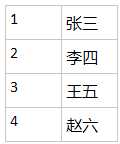标签:generated ted 技术 run out filename 代码 imp 静态方法
1.计算程序运行时常
long start = System.currentTimeMillis(); … … … long end = System.currentTimeMillis(); System.out.println("程序运行时常 : "+(end-start)+" ms");
String fileName = "/home/test";//定义写文件路径 FileWriter writer = null;//文件读写流 public void write_To_File(){ writer = new FileWriter(fileName, true); try { writer.write("Hello World!"); } catch (IOException e) { // TODO Auto-generated catch block e.printStackTrace(); } }
设置布尔变量,用来在程序运行时对一些逻辑进行标记。其中false和true需要自己定义其含义。因此在设置flag的时,需要注意false以及true对应的含义。否则这些逻辑上的错误很难被检查出来。
boolean flag = true; … … If() } … /* 根据程序运行逻辑进行对flag的修改 */ else{ }
声明myMap为HashMAp类型
HashMap<String,String> myMap=new HashMap<String,String>();
其中HashMap中的第一个参数,第二个参数为String
可以使用HashMap来构造key,value一一对应的结构。
例如:学号对应一个姓名

则可以使用put来构造HashMap
myMap.put("1","张三");
myMap.put("2","李四");
myMap.put("3","王五");
myMap.put("4","赵六");
可以使用get来查看key对应的value
myMap.get("1");//会返回张三
String path = "/home/allNumber.csv"; public static ArrayList<String> myList = new ArrayList<String>();//声明list, 内容为String类型 public static void createList(String path) throws IOException{ BufferedReader reader = new BufferedReader(new FileReader(new File(path))); String line = ""; while((line=reader.readLine())!=null){//赋值并进行判断 if(!myListlist.contains(line )){//去重 myList.add(line ); } } reader.close(); }
首先声明文件读写流,传入参数path为文件路径;
while循环体中需要判断是否已经到了文件的末尾,同时进行赋值操作;
由于需要进行去重操作,只需要每次向myList中添加数据之前前进行判断该数据是否已经存在;
记住最后要将文件的读写流关闭 reader.close();
使用静态方法
public class test { public static void executeFixedRate() throws IOException { ScheduledExecutorService executor = Executors.newScheduledThreadPool(1); /* * 参数1 new count() 表示运行的方法 * 参数2 0 表示第一次调用等待 0ms 之后运行count中的run方法 * 参数3 5000 表示之后每经过5000ms再次调用 * 参数4 TimeUnit.MILLISECONDS 设置时间为毫秒 */ executor.scheduleAtFixedRate(new count(),0,5000,TimeUnit.MILLISECONDS); } static class count implements Runnable{ private String fileName = "/home/test"; private FileWriter writer = null; //设置日期格式 private static DateFormat df = new SimpleDateFormat("yyyy-MM-dd HH:mm:ss"); public void run(){//运行代码 try { writer = new FileWriter(fileName, true); writer.write("Hello World"+df.format(new Date())+"\n"); writer.flush(); } catch (IOException e) { // TODO Auto-generated catch block e.printStackTrace(); } } } public static void main(String[] args) throws Exception { test.executeFixedRate(); } }
使用Timer类
public class test { private static void executeFixedRate() { Timer timmerTask = new Timer(); Calendar calEnviron = Calendar.getInstance(); // 每00:00:00 开始执行 calEnviron.set(Calendar.HOUR_OF_DAY, 0); calEnviron.set(Calendar.MINUTE, 0); calEnviron.set(Calendar.SECOND, 0); // date制定间 Date dateSetter = new Date(); dateSetter = calEnviron.getTime(); // nowDate前间 Date nowDateSetter = new Date(); // 所间差距现待触发间间隔 long intervalEnviron = dateSetter.getTime() - nowDateSetter.getTime(); if (intervalEnviron < 0) { calEnviron.add(Calendar.DAY_OF_MONTH, 1); dateSetter = calEnviron.getTime(); intervalEnviron = dateSetter.getTime() - nowDateSetter.getTime(); } //第一次运行直接运行test的run if(flag_first){ timmerTask.schedule(new count(), 0, 1 * 1000 * 60 * 60 * 24); }//以后都经过触发间隔之后运行 else{ timmerTask.schedule(new count(), intervalEnviron, 1 * 1000 * 60 * 60 * 24); } } static class count implements Runnable{ private String fileName = "/home/test"; private FileWriter writer = null; //设置日期格式 private static DateFormat df = new SimpleDateFormat("yyyy-MM-dd HH:mm:ss"); public void run(){//运行代码 try { writer = new FileWriter(fileName, true); writer.write("Hello World"+df.format(new Date())+"\n"); writer.flush(); } catch (IOException e) { // TODO Auto-generated catch block e.printStackTrace(); } } } public static void main(String[] args) throws Exception { test.executeFixedRate(); } }
标签:generated ted 技术 run out filename 代码 imp 静态方法
原文地址:http://www.cnblogs.com/zpfbuaa/p/6011198.html